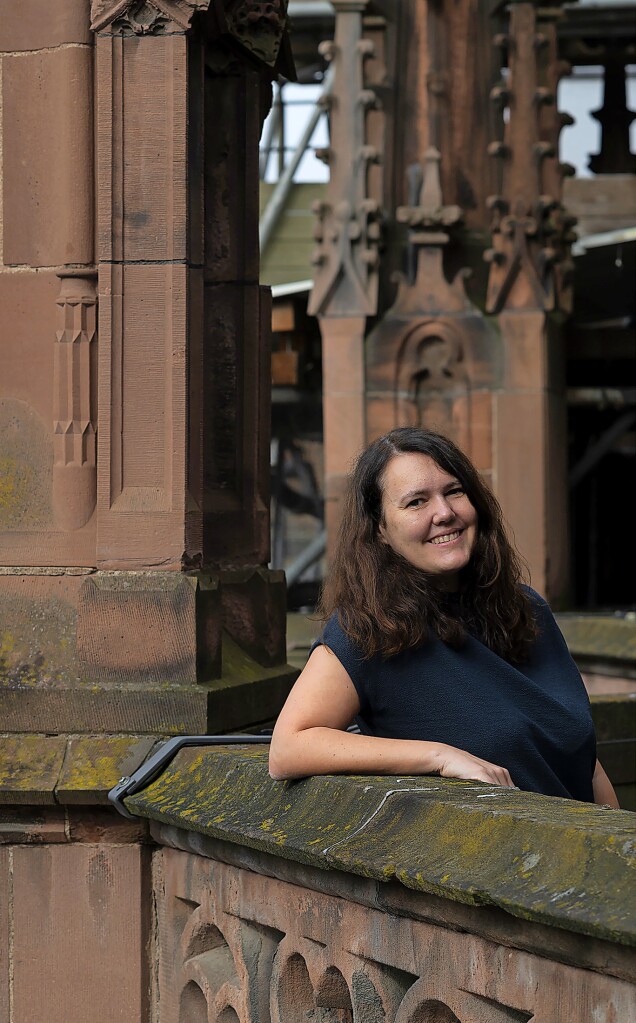Visit master builder Anne Kristen Brimm.
Its biggest task will be the renovation of the choir of the late High Middle Ages, which began eight years ago and will continue for 25 years: Anne Christine Bremm is the builder of the new Freiburg cathedral. The architect from Kander has been in the position for a month and is well prepared for this task, as she wrote her doctoral thesis on the compositional builder of the choir, Hans Nisenberger, and completed her qualification with a thesis on Ulm Minster.
Anne Kristen Bremm can laugh quite contagiously. You are supposed to take a picture, high up by the choir, in a place that was actually intended for a statue, but was never erected. She was just interested in medieval steel construction. But now doubts arise, knowing that below the console on which it is supposed to stand, it extends about 15 meters to Münsterplatz. “It was built for a statue for sure, and it would have been a lot heavier than me—I hope so,” she encouraged herself, but she prefers to distance herself from the photo. Common sense won. “You never know…”
Her fascination with churches and Gothic awakened in her childhood. It was her father in charge, who traveled with the family to France, mainly to see Romanesque churches. She remembers how he stood in the church among the columns, “as in the woods with trees,” and how his stories sparked the imagination of his children. “He gave us that, and that’s what you keep,” Prehm says. She was also enthusiastic about the Romans and their techniques, saying for example: “It was amazing what was possible there, pouring concrete under water.” Or the giant dome of the Pantheon in Rome.
It first came to the Late Gothic and its PhD subject through Johann Josef Becker, doctoral supervisor and specialist of the period: Hans Nisenberger was a master builder always called upon when statically sensitive building tasks had to be mastered, as in Freiburg when The year 1471 was to save the high choir, which was under construction and threatened with collapse. Hans Niesenberger was often fired due to alleged serious construction errors, after all he worked in Freiburg for 20 years until this also happened here. Anne-Christine Brehm is sure that Niesenberger was not a failure, but simply worked on several construction sites at the same time.
For them, advantages prevail: miniature construction, its design with light and shade. “You can see it in the upper choir of the Freiburg Minster,” she explains. Meanwhile she can also do something with decorative emojis, but sober and reductive are still more of her thing. “Gothic is actually a structural construct, so it’s a very modern thing.” With less and less materials, building higher and higher, melting down the walls and letting light into the rooms – this could only work because the architects were masons, and the builders were so familiar with stone that they could reach the limit. At the construction site in the upper choir, a cathedral builder watches the masons—three women among them—while backfilling an open joint with mortar, one of many restoration work. It strengthens the stone bond and subsequently becomes invisible.
Many centuries of building history meet in a very small space in the high choir. Medieval elements stand alongside Baroque additions and replicas from the 18th century as well as renovations from the 1930s. The Nissenburger high choir, for Anne Christine Bremm at the center of her research, is daily stone practice at the construction site of the Uwe Zäh smelter and 15 of its stones.
An example of the intricacy of the renovation in detail are the church’s columns, 13 small decorative towers on the outside of the chapel’s wreath. Not designed and installed until the 18th century, it was partially replaced by new neo-Gothic creations of the 1930s and 1940s. But in those years sandstone was used that could not be preserved, so the columns of the entire church must be replaced again today. What was unknown at the time: The Freudenstadt sandstone used consists of layers of materials that swell and dry differently under the influence of the weather, a tensile test that causes the stone to explode after a relatively short time – and this is what happened on the columns of a neo-Gothic church. In the meantime, the tougher and more durable sandstone from a quarry in Tenenbach that newly opened in 2012 is used. “A lot of it was built in the Middle Ages, so you can assume it’s going to last a long time,” says Brehm.
The thrilling story of how stones were used in different eras in Münster can be read in a new book by Münsterbauverein. Just like the choice of materials, the decision in what style replaces weathered church pillars. Should the neo-Gothic column, which was itself an alternative, be reconstructed in a neo-Gothic style? Or in the 18th century adjoining column style? Brehm suffers from a weakness in the as yet unresearched formal language of the eighteenth century in Münster, which “does not copy itself and follows itself as a whole”. And Uwe Zäh doesn’t like the neo-gothic look either: “They made one in the late Gothic style, even better than the original, but it’s weird to us.” So it was decided, in coordination with the State Antiquities Office, in favor of the “sympathetic new creation.”
To rebuild the abutment, for example, the continuous ivy shape was taken again, but the design was left completely blank so that the reconstructions would always remain visible and distinguishable from the originals. Lilies, which were originally bulbous, are now slender.
In November Shown: Wolfgang Werner, Anne-Christine Brahm, Uwe Zah, Stephanie Szumberbrink and Jens Wittenbrink: Freiburg Cathedral. Cathedral stones. Origin – Extraction – Use from the Middle Ages until today. Münsterbauverein Publication Series, No. 10.

Communicator. Reader. Hipster-friendly introvert. General zombie specialist. Tv trailblazer

